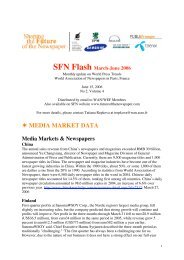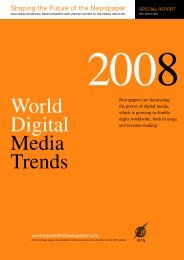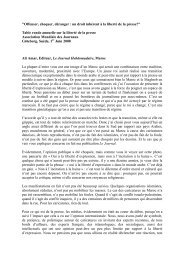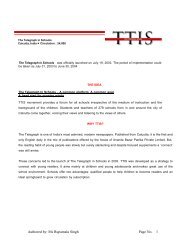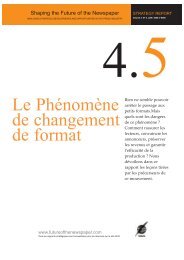WORLD PRESS TRENDS - World Association of Newspapers
WORLD PRESS TRENDS - World Association of Newspapers
WORLD PRESS TRENDS - World Association of Newspapers
You also want an ePaper? Increase the reach of your titles
YUMPU automatically turns print PDFs into web optimized ePapers that Google loves.
JAPAN<br />
JAPAN<br />
Commentary - Nihon Shinbun Kyokai (NSK - The Japan Newspaper Publishers and Editors <strong>Association</strong>)<br />
In the second straight year <strong>of</strong> decline, Japan’s nominal GDP<br />
shrank by 1.4% in 2002. Consumer prices, share prices and land<br />
prices all continued to fall, while the number <strong>of</strong> bankruptcies<br />
and unemployment rose. Japan is now struggling to stem<br />
deflation by encouraging business realignments, eliminating<br />
concerns about the financial system and boosting private-sector<br />
demand.<br />
The sluggish Japanese economy depressed newspaper<br />
advertising sales. According to Dentsu, which compiles<br />
advertising statistics, newspaper advertising sales fell by 11.0%<br />
in 2002, after falling 3.6% in 2001. The double-digit plunge was<br />
the largest ever, surpassing the previous record <strong>of</strong> 9.5% decline<br />
in 1992, when Japan’s bubble economy collapsed. <strong>Newspapers</strong><br />
fell by more than other media like television and radio.<br />
<strong>Newspapers</strong>’ share <strong>of</strong> total advertising expenditure fell from<br />
19.9% in 2001 to 18.8% in 2002, primarily because <strong>of</strong> sharply<br />
lower expenditure by the information, communications, finance<br />
POPULATION<br />
and insurance-related industries. As a result, newspaper<br />
companies need to develop new advertisers and take every<br />
possible measure to boost advertising sales in a very competitive<br />
environment: in particular the internet continues to expand its<br />
share <strong>of</strong> the market, while new magazines are continually being<br />
developed.<br />
Meanwhile, newspaper copy-sales revenues have remained<br />
level since 1995, according to a survey on newspaper business<br />
trends conducted by Nihon Shinbun Kyokai (The Japan<br />
Newspaper Publishers & Editors <strong>Association</strong>). This has<br />
generally helped newspaper publishers remain pr<strong>of</strong>itable<br />
despite their falling advertising revenues.<br />
In an effort to secure pr<strong>of</strong>its, newspaper companies have been<br />
redoubling their efforts to cut down on personnel, paper, raw<br />
materials and other costs. However, they are expected to report<br />
sharp falls in pr<strong>of</strong>its for the year ending March 2003.<br />
Population by age and sex<br />
All individuals Male Female Households<br />
000 % 000 % 000 % 000<br />
Children 18,119 14 9,283 15 8,836 14 46,781<br />
15-24 15,152 12 7,739 12 7,413 11<br />
25-34 18,927 15 9,678 16 9,249 14<br />
35-44 15,673 12 7,957 13 7,716 12<br />
45-54 19,165 15 9,627 16 9,538 15<br />
55-64 16,359 13 8,017 13 8,342 13<br />
65+ 23,083 18 9,671 16 13,412 21<br />
Total 126,478 100 61,972 100 64,506 100<br />
Source: Residential Register, Home Affairs Ministry<br />
Age structure <strong>of</strong> readership (1999)<br />
% weekly reach within<br />
Age<br />
age group<br />
10-19 77.1<br />
20-29 88.1<br />
30-39 95.0<br />
40-49 96.3<br />
50-59 96.9<br />
60+ 92.0<br />
Source: NSK<br />
Newspaper reach (%)<br />
Daily<br />
All adults 78.3<br />
Men 82.1<br />
Women 75.2<br />
Source: NSK (2001)<br />
Housewives (co-habiting persons)<br />
Housewives<br />
000<br />
under 25 497<br />
25-34 5,088<br />
35-44 6,409<br />
45-54 8,033<br />
55-64 6,590<br />
over 65 5,819<br />
Total 32,436<br />
Source: 2000 Population Census<br />
Households (2000)<br />
Households<br />
Occupancy 000<br />
1 person 12,911<br />
2 people 11,743<br />
3 people 8,810<br />
4 people 7,925<br />
5 or more people 5,392<br />
without children 28,375<br />
with children 18,407<br />
with oldest child aged 0-6 5,356<br />
with oldest child aged 7-18 13,051<br />
Total 46,781<br />
Source: 2000 Population Census<br />
NUMBER OF TITLES AND CIRCULATION<br />
Change (%)<br />
1998 1999 2000 2001 2002 98/2002 2001/02<br />
Number <strong>of</strong> titles<br />
Total dailies 108 109 110 106 106 -1.85 0.00<br />
National dailies 5 5 5 5 5 0.00 0.00<br />
Regional dailies 92 93 94 90 90 -2.17 0.00<br />
Sports dailies 11 11 11 11 11 0.00 0.00<br />
Non-dailies 1 - - - - - -<br />
Free papers 106 122 153 158 179 68.87 13.29<br />
Circulation (000)<br />
Total dailies 72,410 72,218 71,896 71,694 70,815 -2.20 -1.23<br />
National dailies 40,450 40,318 40,332 40,229 39,773 -1.67 -1.13<br />
Regional dailies* 25,579 25,608 25,257 25,344 25,234 -1.35 -0.43<br />
Sports dailies 6,380 6,293 6,307 6,122 5,808 -8.97 -5.12<br />
Free papers 16,460 18,066 19,915 21,190 21,576 31.08 1.82<br />
Source: NSK, except free papers, which are from Japan ABC<br />
*includes specialised dailies<br />
Many Japanese dailies print morning and evening editions as well as on Sundays.<br />
All regional ediitons published by the regional HQ <strong>of</strong> the same company are counted as<br />
one title<br />
Titles<br />
112<br />
111<br />
110<br />
109<br />
108<br />
107<br />
106<br />
105<br />
104<br />
103<br />
102<br />
101<br />
100<br />
Number <strong>of</strong> daily titles and circulation<br />
Titles<br />
Circulation<br />
1998 1999 2000 2001 2002<br />
73,000<br />
72,500<br />
72,000<br />
71,500<br />
71,000<br />
70,500<br />
70,000<br />
Circulation (000s)<br />
160<br />
<strong>WORLD</strong> ASSOCIATION OF NEWSPAPERS - <strong>WORLD</strong> <strong>PRESS</strong> <strong>TRENDS</strong> 2003





